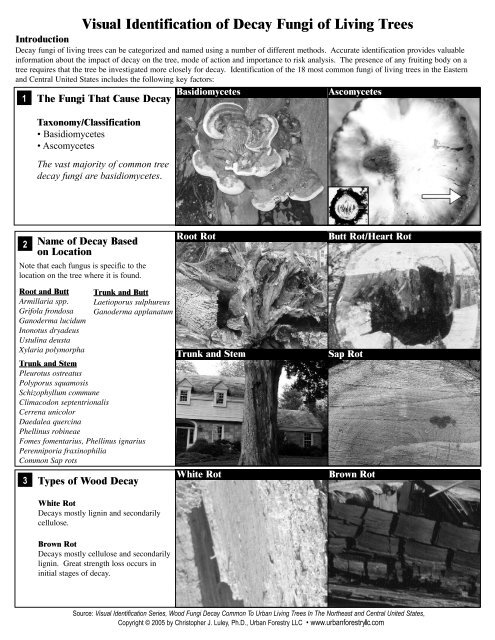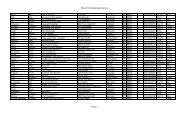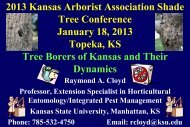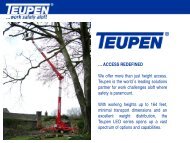Decay Fungi
Decay Fungi
Decay Fungi
- No tags were found...
You also want an ePaper? Increase the reach of your titles
YUMPU automatically turns print PDFs into web optimized ePapers that Google loves.
Visual Identification of <strong>Decay</strong> <strong>Fungi</strong> of Living TreesIntroduction<strong>Decay</strong> fungi of living trees can be categorized and named using a number of different methods. Accurate identification provides valuableinformation about the impact of decay on the tree, mode of action and importance to risk analysis. The presence of any fruiting body on atree requires that the tree be investigated more closely for decay. Identification of the 18 most common fungi of living trees in the Easternand Central United States includes the following key factors:BasidiomycetesAscomycetes1 The <strong>Fungi</strong> That Cause <strong>Decay</strong>Taxonomy/Classification• Basidiomycetes• AscomycetesThe vast majority of common treedecay fungi are basidiomycetes.2 Name of <strong>Decay</strong> Basedon LocationNote that each fungus is specific to thelocation on the tree where it is found.Root RotButt Rot/Heart RotRoot and ButtArmillaria spp.Grifola frondosaGanoderma lucidumInonotus dryadeusUstulina deustaXylaria polymorphaTrunk and ButtLaetioporus sulphureusGanoderma applanatumTrunk and StemPleurotus ostreatusPolyporus squamosisSchizophyllum communeClimacodon septentrionalisCerrena unicolorDaedalea quercinaPhellinus robineaeFomes fomentarius, Phellinus ignariusPerenniporia fraxinophiliaCommon Sap rots3 Types of Wood <strong>Decay</strong>Trunk and StemWhite RotSap RotBrown RotWhite Rot<strong>Decay</strong>s mostly lignin and secondarilycellulose.Brown Rot<strong>Decay</strong>s mostly cellulose and secondarilylignin. Great strength loss occurs ininitial stages of decay.Source: Visual Identification Series, Wood <strong>Fungi</strong> <strong>Decay</strong> Common To Urban Living Trees In The Northeast and Central United States,Copyright © 2005 by Christopher J. Luley, Ph.D., Urban Forestry LLC • www.urbanforestryllc.com
• Annual• Fleshy mushrooms with gillsGeneral Key to Wood <strong>Decay</strong> <strong>Fungi</strong>Armillaria spp.Pleurotus ostreatusSchizophyllum commune• Annual• Tougher and woody with poresGanoderma lucidumInonotus dryadeus• Annual• Soft and fleshy with poresGrifola frondosaLaetiporus sulphureusPolyporous squamosus• Annual• Soft and fleshy with toothed pore layerClimacoden septentrionalis• Annual/Perennial• Maze-like pore surfaceDaedalea quercinaCerrena unicolor• Annual• Numerous small fruiting bodies with gills, smooth or poresSap rot• Perennial• Hard and woody with poresFomes fomentarius, Phellinus ignariusGanoderma applanatumPerenniporia fraxinophilia, Phellinus robineae• Annual/Perennial• Black or whitish-gray and crustyXylaria polymorpha, leftUstulina deustaUstilina deutusumInformation and photographs provided based on Visual Identification Series, Wood <strong>Fungi</strong> <strong>Decay</strong> Common To Urban Living Trees In The Northeast andCentral United States, Copyright © 2005 by Christopher J. Luley, Ph.D., Urban Forestry LLC • www.urbanforestryllc.com








